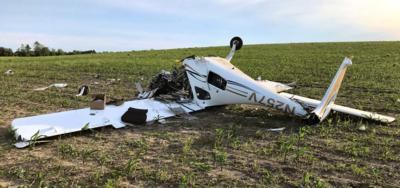Sun, Jun 14, 2020
Automatic Dependent Surveillance-Broadcast Data Is Contributing To The Investigation
Location: Beecher, IL Accident Number: CEN20LA219
Date & Time: 06/08/2020, 0946 CDT Registration: N257V
Aircraft: Flight Design CTLS Injuries: 1 Fatal
Flight Conducted Under: Part 91: General Aviation - Personal

On June 8, 2020, at 0946 central daylight time, a Flight Design GMBH CTLS airplane, N257V was destroyed when it was involved in an accident, near Beecher, Illinois. The pilot was fatally injured.
The airplane had just departed from runway 09 at the Bult Field airport (C56). There were no witnesses to the accident but preliminary Automatic Dependent Surveillance-Broadcast (ADSB) data showed the airplane accelerated to about 60 kts. groundspeed and climbed to about 75 ft. above ground level (agl). The groundspeed then decreased to about 50 kts while the altitude continued to increase until it reached about 175 ft agl. At that time, the airplane was about 300 ft short of the departure end of the runway and began a descending left turn. During the turn the groundspeed remained about 50 knots. The accident site was about 300 ft and 10° from the last recorded data point and about 0.4 miles northeast of the departure end of the runway.
The field was a flat recently planted corn field. The corn plants were about 3-4 inches tall and the ground was firm, dry, and hard packed.

There were three linear marks at the accident site that were consistent with having been made by the airplane's tricycle landing gear. The center depression was deeper and longer, indicating that the airplane impacted in a nose low attitude. The airplane's nose landing gear and right main landing gear separated from the airplane and the airplane nosed over on its back. The forward fuselage was crushed rearward and upward into the cabin area. The wings were predominately intact and still attached to the fuselage. The empennage of the airplane was intact but separated from the remainder of the fuselage at the leading edge of the vertical tail.
The airplane was powered by a Rotax 912 ULS engine that had been modified with the addition of aftermarket electronic fuel injection and turbocharger systems.
A postaccident examination of the airframe and engine will be conducted at a later date.
More News
Aero Linx: Model Aeronautical Association of Australia MAAA clubs are about fun flying, camaraderie and community. For over 75 years, the MAAA has been Australia’s largest fl>[...]
Touchdown Zone Lighting Two rows of transverse light bars located symmetrically about the runway centerline normally at 100 foot intervals. The basic system extends 3,000 feet alon>[...]
“Discovery and innovation are central to our mission at Virgin Galactic. We’re excited to build on our successful record of facilitating scientific experiments in subor>[...]
How To Get A Story On Aero-TV News/Feature Programming How do I submit a story idea or lead to Aero-TV? If you would like to submit a story idea or lead, please contact Jim Campbel>[...]
Student Pilot Reported That During Rotation, “All Of A Sudden The Back Of The Plane Kicked To The Right..." Analysis: The student pilot reported that during rotation, “>[...]
 ANN's Daily Aero-Linx (05.02.24)
ANN's Daily Aero-Linx (05.02.24) ANN's Daily Aero-Term (05.02.24): Touchdown Zone Lighting
ANN's Daily Aero-Term (05.02.24): Touchdown Zone Lighting Aero-News: Quote of the Day (05.02.24)
Aero-News: Quote of the Day (05.02.24) ANN FAQ: Contributing To Aero-TV
ANN FAQ: Contributing To Aero-TV NTSB Final Report: Cirrus Design Corp SR20
NTSB Final Report: Cirrus Design Corp SR20




